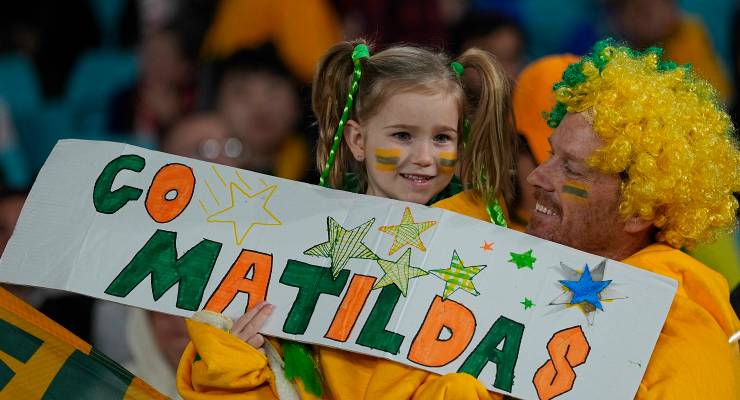
Wednesday night saw the end of the Matildas’ nation-gripping FIFA Women’s World Cup pursuit, losing 3-1 to England in the semi-final in Sydney.
While it was an emotional finish to Australia’s exciting run, the match only further highlighted the record-breaking audiences experiencing the fan culture of women’s football.
This fandom has a notably different flavour from traditional men’s sports fan culture, and could be the defining legacy of the tournament.
A space for all
Women’s football, and most women’s sports, allow space for different fan cultures to come together in a safer and more inclusive environment.
These cultures have been developed over time by those who have felt excluded by traditional sporting environments that can promote toxic elements of masculinity and require fans to behave in particular ways.
Fans in many male sporting cultures are expected to have prior knowledge, understand rules and intricacies of the game, wear particular merchandise and use specific language to show support. If fans don’t comply with these set behaviours, they can feel like they don’t belong.
Research has shown this is a particularly complicated experience for women. To fit in and feel part of men’s sporting fan culture, they have to modify parts of their gender identity.
Women’s sports create an environment where fans can come as they are, not as who they think they should be. This welcomes everyone to the game, especially people who might have previously looked at sport and thought it wasn’t for them.
A history of exclusion
It is no accident these spaces are welcoming, and speaks to the history of active exclusion women have faced in football.
Women’s international football took off in Australia in the mid-to-late 1970s, with the first recognised game between Australia and New Zealand. Coverage was scarce, and even when it was present, it was often sexist and demeaning.
The timing of this growth of the game is no coincidence, aligning with the FA’s (English Football Association) lifting of the 50-year ban on women’s football in England. The FA didn’t have the power to ban women from playing entirely, so in 1921 it ruled that women’s games couldn’t be played on FA-affiliated grounds.
This hindered the development of football not only in the UK but around the world, as other nations echoed similar positions.
That there was an international team representing Australia in 1979 is credit to the women, and supportive men, who built spaces for women and girls to play.
In creating new clubs, teams and competitions, they created environments demonstrating values that were the opposite of those that had previously excluded them.
Fans returning to the sports they love
These welcoming cultures aren’t exclusive to football. Many women’s sporting clubs in Australia have played key roles in contributing to the growing audiences that elite codes are experiencing today. Women’s sporting codes aren’t just attracting new fans but are also reengaging fans formerly lost to sport.
Research I conducted into the developing fan culture of the AFLW found many fans came to women’s Australian Rules football because they were interested in the code but felt alienated by the culture of the men’s game.
Fans shared that AFLW offered a more inclusive culture, and they didn’t have to navigate how to support athletes accused of domestic violence or sexual assault and fear racist or homophobic language. Fans also felt they could do things such as change teams and support multiple teams. People were fans of the competition more broadly and also wanted to generally support women playing the sport they love.
These findings aren’t just bound to Australia. There were distinctly different fan experiences at the men’s and women’s European Football Championships held in 2021 and 2022. Both finals were played in England and featured the hosts.
The men’s final was marred by fan violence, altercations with police and racism, while the women’s competition presented a safe, friendly and inclusive environment.
Fans of women’s sport around the world are rejecting traditional masculine norms of sports fandom, and developing a counter fan culture.
Inclusive supporter groups
Trailblazing volunteers, administrators, coaches and athletes built these spaces for women and non-binary folk to play. But there are also passionate fans on the ground continuing to drive the fan culture.
One group bringing the noise this Women’s World Cup is Matildas Active Support, which states “inclusivity is at our core”. The group coordinates meet-ups pre- and post-match, leads chants at the games and brings fans together on social media. The group welcomes everyone to their events, whether that be singing at the top of their lungs or quietly taking it all in.
Diverse fan support like this adds to the family-friendly atmosphere at women’s football, where families with children feel more comfortable to attend, and women in particular feel safe to attend matches alone.
Fans the legacy of this world cup
It’s important women athletes are visible in the media to show the next generation what is possible, and the Matildas are definitely achieving this. But the visibility of fandom and the culture that surrounds women’s football is just as crucial to drive women’s sport forward.
This Women’s World Cup is an opportunity for stakeholders to learn more about the different ways fandom is experienced, and how to connect with diverse fans to continue to grow the audience beyond the tournament and in other women’s sports.
What’s been clear over the past month is that record numbers of women’s football fans have rejected traditional masculine forms of sporting fandom for more inclusive, safe and friendly expressions.
These fans have been seen. They now must be heard to continue to build on this momentum for women’s sport.
This was republished from The Conversation









Another significant difference was the quality of the TV commentary. The commentators were professionally calm, considered and informative. They did not have to shout and there was no macho-like exclamations…yes, women were playing. Collisions between players were not greeted with an over-hyped voyeurism. There was clearly respect shown between the women playing and even condolences expressed by the winners to the losers. I have noted that during cricket broadcasting, if one of the commentators is a woman, the men tone down their commentary. It was just bloody marvellous. Go girls, show the way.
Odd. David Basheer and Simon Hill, who did the commentary on the Optus coverage I watched, also do most of the commentary when SBS have WC football. Who are the ones that shout and proffer those “macho-like exclamations”…surely not Martin Tyler?
I was thinking of the rugby league commentators in Oz. In the past when I did watch football on TV, I felt the English football (soccer) commentators would say only enough without embellishment. Asutralian cricket commentators seem to be paid by the number of words.
By and large 7’s game commentary was ‘OK’ but lacklustre, it only lifted anytime Simon Hill was on. What the hell Bruce McAvaney was doing on the half time panel heaven knows.
With generally poorer ball skills to some of their opponents the Matildas jagged their way through to the semis with enthusiasm, teamwork and a great goalie. The fabulous spectators were part of it too. The US ref was a disappointment, but the final few rounds of a world cup generally have the ref under orders to let the play flow, and she seemed unwilling to card the poms for flagrant professional fouls. Kerr’s goal, taking the ball in her own half, was world class. Pele would have been proud of it. We had some luck in the previous two games but none in the semi final, and that’s that. The women lost with good grace, as they played. Men’s soccer in this country is rubbish by comparison. How could it not be, with characters like S Kerr playing – the way she dealt with the male pitch invader last year won me over for ever. The Matildas (and free-to-air) forever!
I love the Matildas, the crowds, the gentle but high decibel excitement, the astonishing quality of football.
Compare and contrast. In the late 1970s and early 1980s I used to frequent the “Shed” at Stamford Bridge to watch a nominally professional football team provide unpredictable football on the field and predictable refreshments and aggro on the terraces. Derbies with Millwall were a particular pleasure: the visitors wore the same scarves as we did, and so could mingle incognito, but they smuggled in some quite businesslike weapons. And Millwall fans were tame compared to Red Star Belgrade fanatics, or the Auteuil end of Paris St Germain, or the north Italian ultras.
As I got older I got pretty repelled by it. The point, though, was that the men’s game was, and still is, a way of drawing out and rendering relatively harmless some of the awful instincts that seem never to be far below the surface of humanity. The culture of the men’s game is repulsive for most of us, but I suggest it serves a deep and valuable purpose.
Much of it has calmed down more responsibility from clubs, more ageing fans etc., though in many nations there is too much ‘ultra’ behaviour.
Further, UK band The Stranglers (due to infamous riots at concerts in France) were euphemistically known as ‘Millwall with musical instruments’ 🙂
I’m not dispirited at all. The Matildas and the whole Oz+NZ program have won new interest throughout the world for the beautiful world game. It has to be sustained now by attendance at A- League games and above all, by Govt financial support for parents’ training and club costs, and more playing grounds.Essential is improved media coverage . There are also professional matters of equal pay and team facilities to be overcome. Don’t you love that on ‘the morning after’ a big game in WWCup, we are NOT reading reports of drunken behaviour, fights, rape? sometimes rape?
Think women’s football is on the world’s map outside of Oz and yes, there must be better access to children’s football via FA & A-League i.e. cheaper or free; on coverage regarding crowd behaviour AFL crowd related incidents fly under the radar….. vs A-League or football, it’s -ve headlines
I thought the WAFL (like AFLX that never came to fruition) was another cynical PR exercise by the ‘men’ at AFL House, as there were existing women’s teams/clubs, then poaching cricket and football players for WAFL to play a code that’s been promoted as macho & robust for generations; were they thinking that it would create disinterest in football, the real existential threat to AFL influence?
Let’s hope the inclusiveness and camararderie stays at the core of Womens Team sport. Fair enough they will now expect lots of money to start flowing as it does for the men. This could be the undoing of this wonderful spirit as lots of money changes things and brings in the greed and egos and power-plays that distort the purity of a game and connection to regular people.